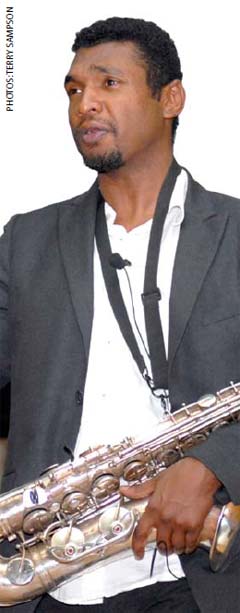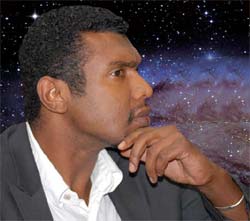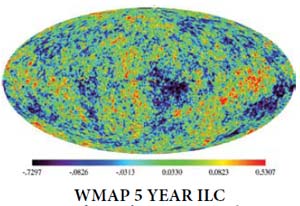 Coltrane and the cosmos Coltrane and the cosmos
Physicist says sound waves explain galaxy formations
“One of my main goals in life is to play a key role in science in Trinidad and Tobago.”
By Vaneisa Baksh
Night after night, Stephon scanned the sky, dreading yet hoping to get a glimpse of Miss Coker flying by. He lived in the village of Basse Terre in the fishing district of Moruga on the southern end of the island, a rural community still unspoilt by city lights and pollution, and perfect for star-gazing. Though he would later discover that Mayaro, just around the corner facing east, offered a uniquely unfiltered natural observatory, the six-year-old was more intrigued by the prospect of seeing Miss Coker in her soucouyant form as a ball of fire than any twinkling constellation.
All that changed when two years later his family migrated from Trinidad to New York City in the USA. Stephon carried his terror of soucouyants with him, but discovered that the Bronx skyline offered no galactic views to fuel his imagination, so he had to create a whole new universe. Old monsters were left behind as new adventures came.
He got hooked on video games and comic books, immersing himself in the world of the imagination, walking neighbourhood streets, listening to guys on the school bus battle it out with their rap and hip-hop, and taking piano lessons to keep it real. His father, Keith, was a computer technician and one day he brought home a second-hand computer (a Commodore), and Stephon, ever the adventurer, began designing programmes to enhance his video games. One thing led to another; in a library seeking information, he discovered the words: Quantum Mechanics. It opened the portal to the physics universe and took him to hitherto unimaginable places. Stephon was a ball of fire.
He did a BSc and a PhD in Physics and then did postdoctoral research at the Imperial College in London, at SLAC National Accelerator Laboratory and the Institute for Theoretical Physics at Stanford University.
As a theoretical physicist, his research has primarily been to help understand large issues such as the nature of dark energy, the origin of matter over anti-matter and neutrino masses, for instance. He’s probed the Big Bang extensively, including a project that seeks to stimulate the moments right after it occurred, using a particle accelerator called the Large Hadron Collider. Essentially, this LHC is on a quest to find the Higgs particle that will theoretically complete the standard model (a theory that unifies the forces, except gravity). It must be the Eureka moment for physicists, though it might end some research careers.
In all its complexity, it is fascinating to try to grasp the concept that without Higgs there’d be no explanation for mass movement, and all substance would travel at the speed of light. To the untrained mind, it can either mean nothing, or too much.
Fortunately, Stephon is a natural performer, so when he explains what he is about, he communicates in simple, graphic terms but with such a high degree of intensity and passion that one is swept along. And it helps that he plays the saxophone to illustrate his theories.
It is because of his highly entertaining presentations that Professor Stephon Alexander was asked to lecture at the 31st International School for Young Astronomers (ISYA) which was hosted by the Physics Department of The UWI in December 2009. Head of the Physics Department and co-chair of ISYA 2009, the indefatigable Dr Shirin Haque-Copilah said that because they particularly wanted to get young people excited by the study of physics and astronomy, they felt Stephon was the perfect choice.
He did not disappoint. From the time he landed at Piarco International at 1.30am and had his regulation doubles and Carib, she said, he was like the man at the speed of light who’d never heard of Peter Higgs and his particle theories.
At the Daaga Auditorium to deliver his lecture on Music and Cosmology, Stephon recounted his childhood relationship with the village soucouyant while his orhni-clad great aunt waggled her finger delightedly at him and the incorrigible MC, UWI entomologist, Christopher Starr explained for the benefit of foreign students that a soucouyant was a “woman who sucked the happiness out of you.”
Supporting his presentation with still and moving images, Stephon took listeners on a voyage through space and time. Having set the foundation that the universe is made up of galaxies and empty space, and that cosmology studies the formation of galaxies and can now do so more precisely with satellites that take fossil snapshots of the early universe, Stephon built to the premise that the universe expanded from a “hot and dense big-bang into the large and structure-full universe we currently inhabit.”
Explaining it later, he said, “We find the startling picture that the young universe was permeated, not with these structures, but a smooth space with radiation energy. Somehow the radiation cooled as the universe expanded and waves of the radiation swirled into forming the galaxies that we are a part of.”
His lecture was meant to demonstrate that these “initial or primordial waves are actually sound waves.” Using John Coltrane as his musical motif, he invited the audience to imagine the universe as a giant instrument vibrating sound, and that its resonance created patterns that made the galaxies. Obviously his presentation was more complex than that, but Stephon used the Coltrane connection seamlessly (a facility he learned at De Witt Clinton High School in NY, where his Physics teacher was also the music teacher for their jazz ensemble). According to Stephon, Coltrane, the ultimate jazzisimo, used “sheets of sound” on the saxophone (a monophonic instrument) to produce the illusion that different notes were sounding at the same time—the concept of non-linearity. Using a space map from NASA’s Cosmic Microwave Radiation space mission WMAP, Stephon talked about the radiation patterns that fit into the Big Bang theory, but which he could also translate using the concept of sound waves to explain the patterns in the satellite data. It was a fascinating journey, ending rather sexily at 220 Hz, the musical note A.
But then Stephon pulled out his saxophone and played the sounds that he had been speaking, and in that crescendo one could see how music feeds the abstract nature of his mind.
Afterwards, a casual poll of the students in the audience suggested that Stephon’s approach had struck the right chords. Setting up an interview was tricky given conflicting schedules, but with his departure imminent, we agreed to talk over dinner at Satchmo’s. He was thrilled to find trumpeter Errol Ince performing, and quickly went over to pay his respects.
As the evening went by, several things became clear.
Stephon is a musician at heart; not only does he play regularly with a jazz ensemble, but he produces music (a recent combination of soca, samba and jazz is called Toco) and he devotedly explores music to relate it to music theory and physics.
He seems to spend his time living life like there’s no tomorrow. It makes sense if you are a theoretical physicist engrossed in matter spanning billions of years.
He engages everything with considerable energy and focus and his plate is always full. High on his agenda is this desire—common among people who have travelled long and complex journeys—to “give something back” to his homeland.
“One of my main goals in life is to play a key role in science in Trinidad and Tobago,” he says.
His focus is on helping young people to make career choices, to see possibilities, and to enable them by guiding them through scholarships to achieve their goals. This was why he jumped at the ISYA invitation. As a youngster at high school, his guidance counsellor had warned him that he would never get into an Ivy League University. He doesn’t explicitly connect the two, but something about his fervour to empower youth, particularly from “home” carries the resonance of that incident.
It isn’t all talk. More than five years ago he was trying to set up a collaborative of scientists to encourage a “cross pollination” of study mainly by and for Caribbean people. Calling it CARIAS (The Caribbean Institute for Advanced Studies) he proposed that it serve as a convergence point for scientists and their work as well as a teaching centre collaborating with institutions such as The UWI to provide mentoring and training. It has not yet taken off, but undaunted, he keeps trying to forge foundational links. He’s hoping to arrange for more lecture exchanges between The UWI and his affiliates.
If we are serious about developed nation status, he says, “How will this happen without us doing science on our own terms, with our style?” The musician in him adds, “like the way Shadow did his music.”
Asked how he goes about trying to help young people, he says it is in different ways: (I) “directly contact my colleagues and lobby for talented students, (because) these colleagues usually have access to their own funding, and I invite students to visit and give talks so that they can be exposed. If CARIAS existed then we would institute a scholarship fund and target prominent scientists to spend time in Trinidad,” he adds optimistically.
He’s designed his lectures with a high entertainment component to attract young minds and he knows the music gives him a global edge. But simultaneously, there is a heavy consciousness of the land of his birth and the razor edge upon which his people often sit and it lends a crusading air to the confident aura he exudes with such Trini aplomb.
Sitting with him is like being caught in a flurry, and as we drop him off, he invites us in to hear a song on the sax. It is past midnight when he puts his horn to his lips and closes his eyes. Immediately a stillness descends and dark energy fills the space.
 Stephon Haigh-Solomon Alexander is an associate professor of physics at Haverford College. He did his BSc at Haverford College and received his Ph.D. in physics from Brown University in 2000, with a dissertation titled “Topics at the Interface between String Theory and Cosmology.” From 2000 to 2002, he held a postdoctoral fellowship from PPARC (the Particle Physics and Astronomy Research Council of the United Kingdom). He has won the National Science Foundation CAREER award and was elected a National Geographic Emerging Explorer. His research has focused primarily on theoretical cosmology at the interface with particle physics, string theory and quantum gravity. This has included Baryogenesis, CMB Physics, Dark Energy/Cosmological Constant Problem, Topological Defects/Solitons, Non-Perturbative QFT, Physics Beyond the Standard Model and Dark Matter. Stephon Haigh-Solomon Alexander is an associate professor of physics at Haverford College. He did his BSc at Haverford College and received his Ph.D. in physics from Brown University in 2000, with a dissertation titled “Topics at the Interface between String Theory and Cosmology.” From 2000 to 2002, he held a postdoctoral fellowship from PPARC (the Particle Physics and Astronomy Research Council of the United Kingdom). He has won the National Science Foundation CAREER award and was elected a National Geographic Emerging Explorer. His research has focused primarily on theoretical cosmology at the interface with particle physics, string theory and quantum gravity. This has included Baryogenesis, CMB Physics, Dark Energy/Cosmological Constant Problem, Topological Defects/Solitons, Non-Perturbative QFT, Physics Beyond the Standard Model and Dark Matter.
Earlier this month, he was invited to deliver the annual John Wesley Powell Memorial Lecture Keynote address for the AAAS (The American Association for the Advancement of Science), and he plans to feature Trinidad in it. Previous Powell lecturers have included Oliver Sacks and Carl Sagan.
 WMAP 5 YEAR ILC WMAP 5 YEAR ILC
Using a space map from NASA’s Cosmic Microwave Radiation space mission WMAP, Stephon talked about the radiation patterns that fit into the Big Bang theory, but which he could also translate using the concept of sound waves to explain the patterns in the satellite data. (NASA photo)
|





